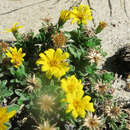Comments
provided by eFloras
Except for Heterotheca monarchensis, H. sessiliflora is the only species in the section with long (more than 0.25 mm), fragile, osteolate-celled hairs on the corolla lobes, and it is the only species native to the central and southern coastal ranges and valleys of California. The species is divided into four subspecies and five varieties differentiated on the basis of indument features, degree of waviness of the leaf margins, and to a lesser extent, stem height and leaf shape. The treatment here is based on J. C. Semple (1996), which includes a key to and descriptions, illustrations, and distribution maps of the varieties.
- license
- cc-by-nc-sa-3.0
- copyright
- Missouri Botanical Garden, 4344 Shaw Boulevard, St. Louis, MO, 63110 USA
Description
provided by eFloras
Perennials, (10–)20–70(–110) cm; taprooted. Stems 1–40+, decumbent to ascending or erect (sometimes ± brittle, sometimes reddish brown), moderately to densely hispido-strigose (long-spreading hairs often broken off), sometimes moderately hairy and densely stipitate-glandular distally (axillary leaf fascicles sometimes present). Leaves: margins flat to strongly undulate; basal and proximal usually withering by flowering; proximal cauline subsessile, blades oblanceolate, (8–)15–40(–60) × (2.4–)4–8(–11) mm, bases cuneate, margins entire, strigoso-ciliate (proximal hairs longer, spreading), apices acute, faces moderately to densely hispido-strigose; distal sessile, blades usually narrowly to broadly lanceolate, sometimes oblanceolate, 6.5–40 × 1.5–8 mm, usually reduced distally, bases rounded, faces sparsely to densely hispido-strigose or short-strigose (5–245 hairs/mm 2 ), sparsely to densely glandular (0–50 glands/mm 2 ). Heads (1–)17–36(–126) in corymbiform or paniculiform arrays, branches ascending. Peduncles 2–100 mm, densely hispid, strigose, or glandular; bracts 2–5+, proximal lanceolate, leaflike, distal reduced, phyllary-like, (2–)2.5–8.5(–13) × (0.3–)0.5–1.8(–4) mm, sometimes a few, large, leafy bracts proximal to heads. Involucres cylindric, turbinate, or campanulate (campanulate upon drying), (6–)7.5–11(–15) mm. Phyllaries in 4–6 series, mid narrowly triangular, unequal (outer lengths 1 / 5 – 1 / 4 inner), margins hyaline, fimbriate-ciliate apically, faces very sparsely to moderately strigose, very sparsely to moderately stipitate-glandular. Ray florets (4–)7–15(–24); laminae (3.5–)4.5–10.5(–18.5) × (0.7–)1–1.7(–2.4) mm. Disc florets (9–)20–50(–81); corollas ± ampliate, (4–)5.5–7(–9.5) mm, glabrous to glabrate, lobes 0.4–1 mm, sparsely pilose (hairs 0.1–1 mm, osteolate-celled ones often fragile). Cypselae monomorphic, obconic, compressed, (1.3–)2–3(–4.5) mm, ribs 6–10, faces sparsely to moderately strigose; pappi off-white, outer of linear scales 0.25–0.5 mm, inner of 25–45 bristles 5–8(–10) mm, longest attenuate to weakly clavate. 2n = 18, 36.
- license
- cc-by-nc-sa-3.0
- copyright
- Missouri Botanical Garden, 4344 Shaw Boulevard, St. Louis, MO, 63110 USA
Synonym
provided by eFloras
Chrysopsis sessiliflora Nuttall, Trans. Amer. Philos. Soc., n. s. 7: 317. 1840; C. villosa (Pursh) Nuttall ex de Candolle var. sessiliflora (Nuttall) A. Gray
- license
- cc-by-nc-sa-3.0
- copyright
- Missouri Botanical Garden, 4344 Shaw Boulevard, St. Louis, MO, 63110 USA
Heterotheca sessiliflora: Brief Summary
provided by wikipedia EN
Heterotheca sessiliflora is a species of flowering plant in the family Asteraceae known by the common name sessileflower false goldenaster. It is native to California, Sonora, and Baja California.
Heterotheca sessiliflora grows in many types of habitats. It is a perennial herb which is quite variable in appearance, particularly across its four subspecies. It may be a small clumping or mat-forming plant or grow tall stems to heights exceeding a meter. It is coated in small bristles or long woolly hairs and it is glandular, particularly around the inflorescence. The flower head contains long yellowish disc florets and the edge is fringed with yellow ray florets.
Subspecies + varieties Heterotheca sessiliflora subsp. bolanderi (A.Gray) Semple
San Francisco Bay area + coast of Redwood Country Heterotheca sessiliflora subsp. echioides (Benth.) Semple - from
San Diego County to
Sonoma County Heterotheca sessiliflora subsp. fastigiata (Greene) Semple - mountains of southern California Heterotheca sessiliflora var. sessiliflora Heterotheca sessiliflora subsp. sessiliflora - from
Baja California north as far as
Santa Clara County Heterotheca sessiliflora var. thiniicola (Rzed. & C.Ezcurra) G.L.Nesom - Gran Desierto de Alta northwestern
Sonora
- license
- cc-by-sa-3.0
- copyright
- Wikipedia authors and editors

